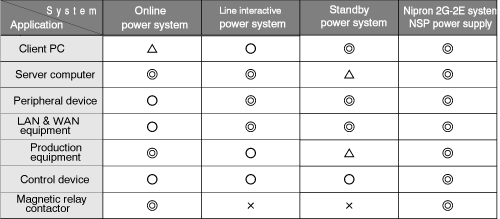As mentioned in 4-1, UPS has a variety of power feeding system
(Standby power system, Online power system, Line interactive system,
Multi-processing power system, and Flywheel power system).
We will discuss operating principle and features of each power feeding
system here.
<< Standby power system >>

Figure 4.2 UPS connection
<Operating principle and its features>
- At normal situation, AC supply mains goes through to output via
surge protection circuit and noise filter while battery is charged.
Also, inverter is not in work so that it does not consume extra
power.
- When blackout is detected, the selector is switched to inverter
side to convert DC voltage from battery to AC voltage as output.
- Switching time is approx. 5msec to 10msec.
- At normal operation, circuit scale is small resulting in small
power consumption and compact with low cost as supply mains goes
through to output.
- Fluctuation of supply mains goes through to output.
- Output voltage waveform during blackout is usually square.
<< Online power system >>

Figure 4.3 Online power system
<Operating principle and its features>
- At normal situation, supply mains is rectified to DC voltage by
diodes, and the DC voltage is converted to AC again by inverter.
At blackout, DC voltage from battery is converted to AC voltage
by inverter. Thus, regardless of normal situation or blackout, power
is fed by inverter.
- Switching to battery needs no interruption so that output voltage
is continuous.
- Power source noise is cut, and output voltage and frequency are
stable even when input voltage fluctuates.
- Power consumption of UPS itself increases as inverter is always
in work.
- This system becomes expensive as circuit structure is complicated.
<Merits and Demerits>
If blackout measures against every power failure is required, it
would be no exaggeration to say that there is no other system than
Online power supply. That said, the device becomes bigger and dramatically
expensive. The price would be 50,000 to 80,000 yen at lowest for
1KW power.
Nipron's 2G-2E system is effective to the extent of Online power
system, but needs to comply with individual equipment. As solution
for this, total system of low cost and backup is summarized in section
5-5-2.
<< Line interactive power system >>

Figure 4.4 Line interactive power system
<Operating principle and its features>
- This system is modified type of Standby power system to newly
implement AVR(Automatic Voltage Regulator: voltage compensation
circuit). Selecting taps of transformer keeps the output voltage
constant even when input voltage changes to approx. 80 to 120V.
- To prevent extra discharge of battery by voltage compensation
function.
- Even at normal situation, as power is supplied to inverter, switching
time of selector is about 4ms which is slightly shorter than Standby
power system.
- Voltage waveform of output is usually sinusoidal with little distorted
shape due to noise filter.
- As transformer is installed, dimension is large and heavy in weight.
<Merits and Demerits>
This system operates based on the presence of input voltage regardless
of waveform. When input voltage waveform is distorted(*), even though
it is not actually blackout, the distorted waveform is mistakenly
judged as blackout by power failure detection circuit which sends
a signal for PC to proceed shutdown. We've seen adverse effects
like this many times. Then operation is forced to stop and service
engineers are called to investigate spending a lot of time. In the
meantime, Nipron's 2G-2E Nonstop power supply in not affected at
all. We have a lot of experiences that customers has solved problems
by switching UPS to Nipron's Nonstop power supply. What we have
to learn is "Be careful with cheap UPS. Nothing is much worse
than cheap UPS."
(*) Power supply used in electric railroad system has largely distorted
waveforms due to its inveter system.

Figure 4.5 Multi-processing power system
<Operating principle and its features>
- Electronic circuit is adopted in stead of voltage compensation
circuit (transformer) of Line interactive power system in this system.
- When input voltage is low, step-up circuit is activated to boost
the input voltage, and step-down circuit is activated to lower the
input voltage when the voltage is high. Thus output voltage is kept
constant. (Input voltage range: 80 to 144V)
- Switching to battery needs no interruption.
- High efficiency, compact and light in weight to compare with Online
power system
<Merits and Demerits>
Different from Online power system, this system switches to battery
only when blackout is detected.
Computers may mistakenly stop due to distorted waveforms as well
as Line interactive power system.
<< UPS comparison table >>
Table 4.1 Features comparison
of UPS system (1)

Table 4.2 Features comparison
of UPS system (2)

Table 4.3 UPS application
comparison

Why is UPS required now?
- As mentioned above, if UPS is to be implemented, it must be absolutely
safe Online power system. But it is expensive and needs large room.
It is not a good idea to pay such a big investment only for short-time
backup in Japan where a few blackouts occur.
- Commencing with computers, almost every equipment which becomes
a load has switching power supply installed to convert AC to DC.
We, Nipron, are in doubt, "Why should we bother generating
alternate current (AC) containing no distorted waveform, utilizing
inverter which becomes expensive?"
|

















